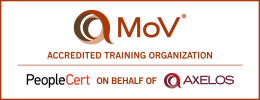10% off ITIL 4 Foundation virtual courses
- Courses & Certifications
-
Project and Programme Management
- Project Management Professional (PMP)®
- Certified Associate in Project Management (CAPM)®
- PRINCE2® 7
- MSP®
- Management of Portfolios (MoP)®
- P3O®
- Management of Risk (M_o_R)®
- MoV®
- APMG-International AgilePM®
- APMG-International Change Management™
- APMG-International Better Business Cases™
- APMG International Project Planning & Control™ (PPC)
- APMG-International Managing Benefits™
- APMG-International PPS™
- Finance for Non Financial Managers
- APMG International Earned Value™
- APM
- Project Management Essentials
- Programme Management Essentials
- Portfolio Management Essentials
- Risk Management Essentials
- Agile Certified Practitioner (PMI-ACP)®
- Risk Management Professional (RMP)®
- Program Management Professional (PgMP)®
- PRINCE2 Agile®
- Scrum (Agile Business Consortium)
- Microsoft Project
- Praxis Framework™
-
Agile
-
DevOps
-
Service Management
-
Commercial Management
-
Business Analysis
-
Lean
-
Software Testing
-
Cyber Security
-
Generative AI
-
Mobile and Software Development
-
Big Data and Analytics
-
Cloud Computing
-
Digital Marketing
| "The ILX Group solution are much better equipped to manage projects in a more cost effective and timely way." NATO |
| "The design of the course material makes it easy for students to navigate through the course and optimise their learning." Brian Bear, Anglo American, South Africa |
| "The ILX Group courses form an important part of our Project training framework." Royal London Insurance |
| "With ILX we can cost effectively deliver a comprehensive training programme." West Middlesex University Hospital |
| "We have used the PRINCE2 Foundation course from ILX Group with excellent results." Salford City Council |
| "We took the PRINCE2 exam brimming in confidence and all passed." Programme Manager, Police IT Organisation (PITO) |
| "I will certainly recommend to anybody who wishes to take PRINCE2 courses in the future." Head of IT Projects, Stanley Leisure PLC |
| "Thanks for an excellent course here at the Authority, all passed :-)" Deputy Director, EFTA Surveillance Authority, Belgium |
| "There is no more to say ... A flexible, well-structured e-learning is the key to a successful project." Benoit Devolder, Navigha SA, Belgium |
| "I have experienced amazing after sales service, which has ultimately put ILX in a league of their own." David Coughlan, The IQ Business Group (Pty) Ltd, South Africa |
MoV® Definition

MoV® Principles, Processes and Techniques
Based around seven principles, the delivery of Management of Value (MoV®) is through seven key processes and supported by an array of techniques.
MoV Principles
Derived from long-standing practice and experience the seven principles represent the factors most instrumental in delivering success. Whilst the application of these principles is not intended to be prescriptive, they are obligatory for good practice in MoV® applications.
- Align with organizational objectives
MoV applications fully align with your organization’s strategic objectives. - Focus on functions and required outcomes
MoV focuses on the functions that are necessary and sufficient in order to deliver the required programme and project outcomes and outputs in terms that clarify what value means for the organization, so providing the basis for making decisions that lead to maximum value. - Balance the variables to maximize value
MoV engages with all key stakeholders, reconciling their objectives to balance benefits and their delivery against the total use of resources, thereby maximizing value. - Apply throughout the investment decision
Applied through all stages of the total lifecycle of the programme or project, the focus of MoV will evolve as it Moves from stage to stage - Tailor to suit the subject
The project’s environment, size, complexity, criticality and risk is used to tailor MoV to suit the subject perfectly. - Learn from experience and improve
MoV applications encourage learning from experience and improvement by recording previous experience, creating an audit trail of decisions and actions and sharing lessons across all projects. - Assign clear roles and responsibilities to build a supportive culture
Clearly defined roles and responsibilities support MoV applications. The organizational structure should engage the business, user and supplier stakeholder interests to build a supportive, value-adding culture.
MoV® Processes
MoV® is delivered in programmes or projects through seven groups of processes that are described in more detail in Chapter 3 of https://www.bestpracticebookstore.com/uk. The seven main headings for MoV processes are:
- Frame the programme or project
This examines how MoV informs the business case, supplementing existing information via specialist techniques. - Gather information
Includes procuring information relating to the project, collecting the expectations from the MoV study, identifying suitable MoV team members, identifying and understanding stakeholders’ needs and other project-related information. - Analyse information
Analysing the gathered information to form useful input to the MoV study. - Process information
Work with the MoV team to use the above input information to develop innovative and value-improving proposals. - Evaluate and select
Select the proposals that have most potential for practical and beneficial implementation. - Develop value-improving proposals
Work-up the outline proposals, into fully developed recommendations for presentation to decision-making management. - Implement and share outputs
Develop the plan for implementing accepted value improvement proposals and monitoring progress. Gathering lessons learned and sharing with others in the organization for continuous improvement.
MoV Techniques
MoV can implement many different techniques. For ease of reference, these are divided into two broad categories:
MoV-specific techniques
Techniques that are either unique or core to MoV. These include Function Analysis and the use of Value Trees and derivatives to assess value for money.
Common techniques used in MoV
Techniques commonly used with – but not exclusive to – MoV. For example, Earned Value Management (EVM) is a useful way to measure project performance, but many other guidances, frameworks and methodologies also use it.
Take a look at our current selection of MoV® courses.

